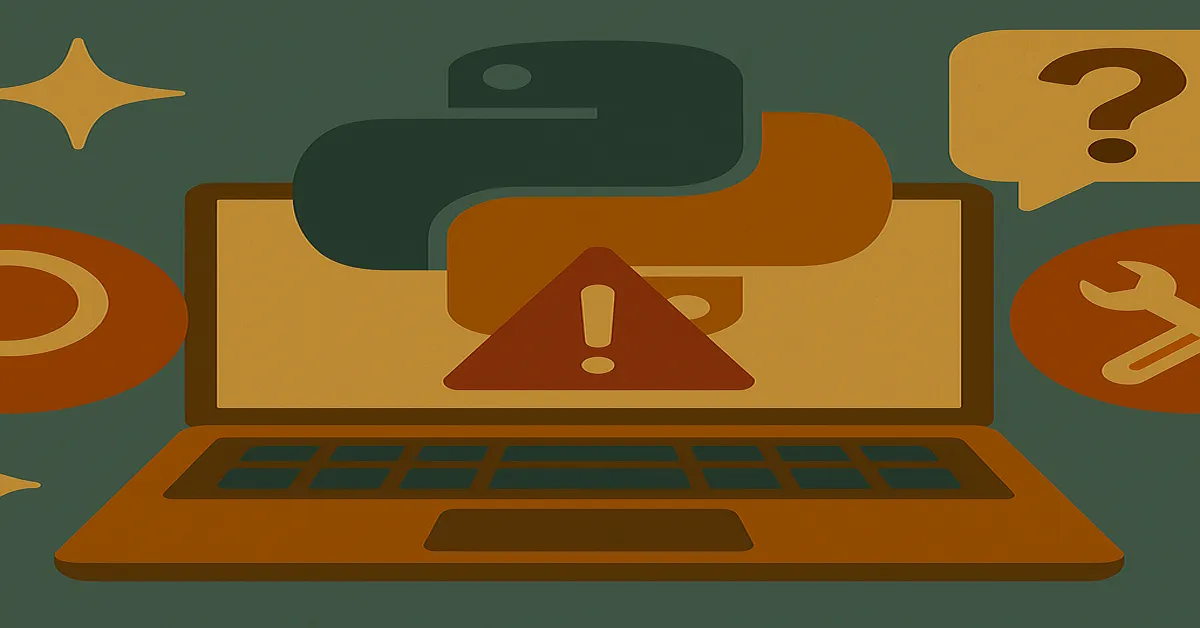Introduction: From Frustration to Mastery
Every programmer, whether beginner or veteran, eventually encounters one of the most inevitable aspects of software development: errors. In the world of Python, a language lauded for its readability and simplicity, errors still occur—but they offer invaluable opportunities to learn. This article is not merely a list of error messages and their fixes. It’s a comprehensive exploration of how to solve errors using Python, with a focus on strategy, tools, mindset, and reproducibility.
To solve errors using Python is to engage in systematic debugging—a process rooted in curiosity, logic, and sometimes even empathy for your own mistakes. Whether you’re writing your first function or scaling enterprise software, understanding how to approach and correct errors is a fundamental part of programming literacy.
The Spectrum of Errors in Python
Before we learn how to solve errors, it’s important to understand what types of errors commonly occur in Python. These fall into several broad categories:
1. Syntax Errors
Errors in the structure of your code, often caught during parsing. Examples include missing colons, unclosed parentheses, and improper indentation.
2. Runtime Errors
These occur while the program is running, often due to operations like dividing by zero or referencing a variable that doesn’t exist.
3. Logical Errors
The code runs without interruption but doesn’t behave as intended. These are often the most challenging to detect because Python doesn’t alert you—they live silently in your outputs.
4. Semantic Errors
Often overlap with logical errors, semantic errors arise when the code is technically correct but conceptually wrong—using the wrong algorithm, for instance.
5. Exceptions
These include both built-in and user-defined issues raised during execution: TypeError, ValueError, IndexError, KeyError, and many more.
Step 1: Reading the Error Traceback
Python’s error traceback is not a punishment—it’s a roadmap. When an error occurs, Python provides a detailed traceback that tells you:
- The type of error
- The line number where it occurred
- The call stack of functions that led there
Example:
pythonCopyEditTraceback (most recent call last):
File "script.py", line 4, in <module>
result = divide(10, 0)
File "script.py", line 2, in divide
return x / y
ZeroDivisionError: division by zero
The traceback tells us precisely where to look and what happened. Your first job in solving errors is not fixing—it’s understanding.
Step 2: Break the Problem Down
Large programs can bury the actual cause of a problem in layers of logic. Use isolation:
- Comment out blocks of code.
- Use print() or logging to track variable values.
- Rewrite minimal versions of the logic to see where it breaks.
Tip: Try to reproduce the error with the least possible code—this is your “minimal reproducible example.”
Step 3: Use Built-in Tools
Python comes with tools that are either built-in or easy to integrate:
1. The pdb Debugger
Python’s built-in debugger lets you step through code line by line:
pythonCopyEditimport pdb
def divide(a, b):
pdb.set_trace()
return a / b
divide(10, 0)
This pauses execution and allows you to inspect variables, move step-by-step, and identify where things break.
2. The traceback Module
Use this for logging or catching complex error chains in applications:
pythonCopyEditimport traceback
try:
run_my_function()
except Exception as e:
traceback.print_exc()
3. Type Checking with mypy
Especially useful for larger codebases, mypy helps catch type mismatches before runtime:
pythonCopyEdit# install via pip install mypy
# then annotate functions:
def greet(name: str) -> str:
return "Hello " + name
Step 4: Pattern Recognition and Common Errors
Solving errors in Python often comes down to identifying patterns. Here are some common errors and what they typically mean:
1. NameError: name 'x' is not defined
You’re referencing a variable that doesn’t exist in the current scope. Check spelling and scope boundaries.
2. TypeError: unsupported operand type(s)
You’re performing operations on incompatible types. For example:
pythonCopyEdit5 + "5" # TypeError
3. IndexError: list index out of range
You’re trying to access an index that doesn’t exist. Check list length.
4. KeyError: 'name'
You’re trying to access a key in a dictionary that doesn’t exist.
5. IndentationError
Python is sensitive to indentation. Even a missing space can break your script.
6. AttributeError: 'NoneType' object has no attribute 'x'
Usually means you’re assuming an object was returned but it was actually None.
Step 5: Searching Strategically
Knowing how to search for a solution is a skill:
- Use the exact error message.
- Include relevant code snippets (but avoid proprietary or personal data).
- Add keywords like
python3,pandas,list comprehension, etc. - Use Stack Overflow, GitHub Issues, Reddit (r/learnpython), or even Python’s own documentation.
Always validate solutions—don’t copy/paste code without understanding it.
Step 6: Logging for Production Errors
If you’re developing a web app or API, raw traceback won’t cut it. Instead:
Use Python’s logging Module
pythonCopyEditimport logging
logging.basicConfig(level=logging.INFO)
try:
run_function()
except Exception as e:
logging.error("An error occurred", exc_info=True)
Logs can be routed to files, external monitoring systems, or error dashboards.
Step 7: Writing Error-Resilient Code
A huge part of solving errors is preventing them. Some best practices:
1. Use Try/Except Sparingly but Wisely
Don’t blanket all code in a try/except. Handle specific exceptions only where you can offer meaningful fallback behavior.
pythonCopyEdittry:
value = int(input("Enter a number: "))
except ValueError:
print("That wasn't a number!")
2. Validate Inputs
Use conditionals to ensure that user input or API responses are safe to process:
pythonCopyEditif not isinstance(data, dict):
raise TypeError("Expected dictionary input.")
3. Write Unit Tests
Using unittest or pytest helps catch problems early. Tests make errors predictable, contained, and documented.
Advanced Techniques: When Errors Get Complicated
1. Debugging Memory Errors
Use memory_profiler or tracemalloc to track down leaks and overuse.
pythonCopyEditimport tracemalloc
tracemalloc.start()
# Run your code
print(tracemalloc.get_traced_memory())
2. Concurrency Errors
These include race conditions or deadlocks in threaded or async code. Tools like asyncio debug mode or threading module diagnostics are essential here.
Debugging in Jupyter Notebooks
Jupyter makes it easy to spot errors thanks to:
- Line-by-line cell execution
- Real-time output
%debugmagic command for post-mortem analysis- Inline traceback expansion
Collaborating on Error Resolution
When working in teams:
- Document known issues in READMEs or Confluence.
- Use GitHub Issues or bug tracking tools like Jira.
- Encourage use of linters (like flake8) to standardize code quality.
Good teams don’t just fix errors—they learn from them, together.
The Psychology of Debugging
Solving errors is also emotional work. Frustration, false leads, and imposter syndrome are common. But every solved bug builds confidence, discipline, and empathy—not only for the machine but for yourself.
Debugging is not failure—it’s refinement.
Summary: Your Python Debugging Toolkit
| Tool | Purpose |
|---|---|
traceback | Display full error chains |
pdb | Interactive command-line debugger |
mypy | Static type checking |
logging | Production-grade error logs |
pytest | Unit testing and assertions |
| Community | Stack Overflow, Reddit, Docs |
Conclusion: A Path Toward Clean, Confident Code
To solve errors using Python is to become more than a coder—you become a diagnostician, an investigator, a teacher to your future self. The best developers aren’t those who avoid errors, but those who resolve them thoughtfully, consistently, and transparently.
So the next time you encounter that mysterious red text in your terminal, don’t panic. Pause. Read. Trace. Test. Learn. Each error is a stepping stone toward better code and a sharper mind.
Read
Python Programming: Tripling Numbers in a List Using Python’s Map Function
Understanding Arithmetic Operators in Python: A Developer’s 2025 Guide
Uncharted Realms of Python: A Guide to Innovative Development Paths
30 Python Interview Questions: A Comprehensive Guide for 2025
FAQs
1. What is the first step I should take when I see an error in Python?
Start by carefully reading the traceback message. It provides the error type, the exact line number where the error occurred, and the function call stack. This information helps you understand what went wrong and where to begin troubleshooting.
2. What are the most common types of Python errors I should know about?
The most common Python errors include:
SyntaxError: Incorrect code structureNameError: Using a variable that hasn’t been definedTypeError: Incompatible operations on data typesIndexError: List index out of rangeKeyError: Missing dictionary key
Understanding these helps you fix most beginner-level issues quickly.
3. How can I debug my Python code more effectively?
Use Python’s built-in tools like pdb for step-by-step debugging, print() or logging to trace variable states, and create minimal reproducible examples. For larger projects, tools like pytest, traceback, and static type checkers (e.g., mypy) are very effective.
4. What should I do if I don’t understand the error message?
Copy the full error message and search it online with context (e.g., the operation or library you’re using). Stack Overflow, Python documentation, and community forums often provide clear explanations and solutions. Be sure to understand the fix rather than just copy-pasting code.
5. How can I prevent errors in my Python code before they happen?
Practice defensive programming:
- Validate inputs and outputs
- Use
try/exceptblocks wisely - Write unit tests with
unittestorpytest - Follow PEP8 standards and run linters like
flake8
Prevention reduces debugging time and increases code reliability.











